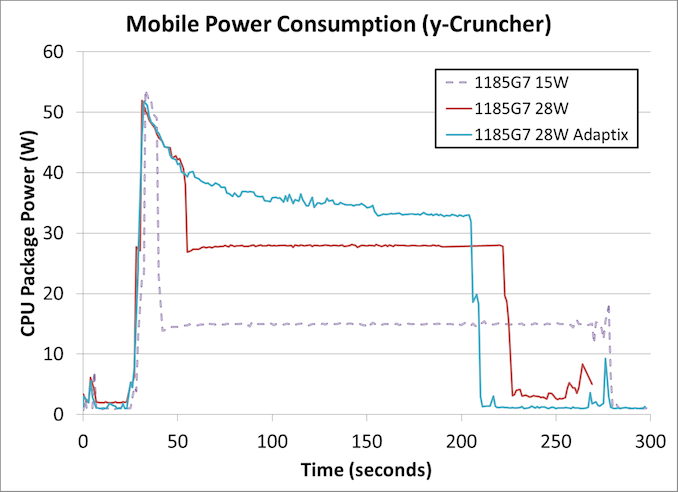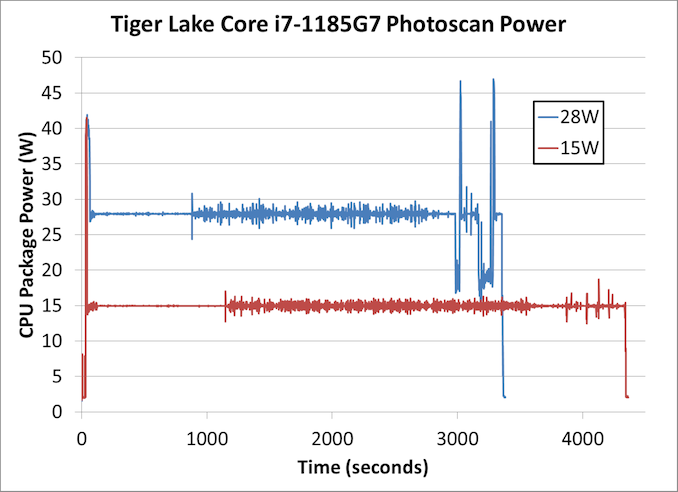Intel’s Tiger Lake 11th Gen Core i7-1185G7 Review and Deep Dive: Baskin’ for the Exotic
by Dr. Ian Cutress & Andrei Frumusanu on September 17, 2020 9:35 AM EST- Posted in
- CPUs
- Intel
- 10nm
- Tiger Lake
- Xe-LP
- Willow Cove
- SuperFin
- 11th Gen
- i7-1185G7
- Tiger King
Comparing Power Consumption: TGL to TGL
On the first page of this review, I covered that our Tiger Lake Reference Design offered three different power modes so that Intel’s customers could get an idea of performance they could expect to see if they built for the different sustained TDP options. The three modes offered to us were:
- 15 W TDP (Base 1.8 GHz), no Adaptix
- 28 W TDP (Base 3.0 GHz), no Adaptix
- 28 W TDP (Base 3.0 GHz), Adaptix Enabled
Intel’s Adaptix is a suite of technologies that includes Dynamic Tuning 2.0, which implements DVFS feedback loops on top of supposedly AI-trained algorithms to help the system deliver power to the parts of the processor that need it most, such as CPU, GPU, interconnect, or accelerators. In reality, what we mostly see is that it reduces frequency in line with memory access stalls, keeping utilization high but reducing power, prolonging turbo modes.
Compute Workload
When we put these three modes onto a workload with a mix of heavy AVX-512 compute and memory accesses, the following is observed.
Note that due to time constraints this is the only test we ran with Adaptix enabled.
This is a fixed workload to calculate 2.5 billion digits of Pi, which takes around 170-250 seconds, and uses both AVX-512 and 11.2 GB of DRAM to execute. We can already draw conclusions.
In all three power modes, the turbo mode power limit (PL2) is approximately the same at around 52 watts. As the system continues with turbo mode, the power consumed is decreased until the power budget is used up, and the 28 W mode has just over double the power budget of the 15 W mode.
Adaptix clearly works best like this, and although it initially follows the same downward trend as the regular 28 W mode, it levels out without hitting much of a ‘base’ frequency at all. Around about the 150 second mark (120 seconds into the test), there is a big enough drop followed by a flat-line which would probably indicate a thermally-derived sustained power mode, which occurs at 33 watts.
The overall time to complete this test was:
- Core i7-1185G7 at 15 W: 243 seconds
- Core i7-1185G7 at 28 W: 191 seconds
- Core i7-1185G7 at 28 W Adaptix: 174 seconds
In this case moving from 15 W to 28 W gives a 27% speed-up, while Adaptix is a total 40% speed-up.
However, this extra speed does come at the cost of total power consumed. With most processors, the peak efficiency point is when the system is at idle, and while these processors do have a good range of high efficiency, when the peak frequencies are requested then we are in a worst case scenario. Because this benchmark measures power over time, we can integrate to get total benchmark power consumed:
- Core i7-1185G7 at 15 W: 4082 joules
- Core i7-1185G7 at 28 W: 6158 joules
- Core i7-1185G7 at 28 W Adaptix: 6718 joules
This means that for the extra 27% performance, an extra 51% power is used. For Adaptix, that 40% extra performance means 65% more power. This is the trade off with the faster processors, and this is why battery management in mobile systems is so important - if a task is lower priority and can be run in the background, then that is the best way to do it to conserve battery power. This means things like email retrieval, or server synchronization, or thumbnail generation. However, because users demand the start menu to pop up IMMEDIATELY, then user-experience events are always put to the max and then the system goes quickly to idle.
Professional ISV Workload
In our second test, we put our power monitoring tools on Agisoft’s Photoscan. This test is somewhat of a compute test, split into four algorithms, however some sections are more scalable than others. Normally in this test we would see some sections rely on single threaded performance, while other sections use AVX2.
This is a longer test, and so the immediate turbo is less of a leading factor across the whole benchmark. For the first section the system seems content to sit at the respective TDPs, but the second section shows a more variable up and down as power budget is momentarily gained and then used up immediately.
Doing the same maths as before,
- At 15 W, the benchmark took 4311 seconds and consumed 64854 joules
- At 28 W, the benchmark took 3330 seconds and consumed 92508 joules
For a benchmark that takes about an hour, a +30% performance uplift is quite considerable, however it comes at the expense of +43% power. This is a better ratio than the first compute workload, but still showcases that 28 W is further away from Tiger Lake’s ideal efficiency point.
Note that the power-over-time graph we get for Agisoft on a mobile processor looks very different to that of a desktop processor, as a mobile processor core can go above the TDP budget with fewer threads.
This leads to the dichotomy of mobile use cases with respect to the marketing that goes on for these products - as part of the Tiger Lake launch, Intel was promoting its use for streaming, professional workflows such as Adobe, video editing and content creation, and AI acceleration. All of these are high-performance workloads, compared to web browsing or basic office work. Partly because Tiger Lake is built on the latest process technology, as well as offering Intel’s best performing CPU and GPU cores, the product is going to be pitched in the premium device market for the professionals and prosumers that can take advantage.












253 Comments
View All Comments
deil - Thursday, September 17, 2020 - link
not rip as intel did respond already few times taking their 5% lead back against ryzen stack.Remember this chip will fight against zen3, which should be ~20% gains on AMD side.
This would be a great chip a year ago it would obliterate 3000 mobile on all fronts BUT against 4800u it seems like a strong contender, but it does not dethrone 4800u as best mobile chip, as you compare 15W with 28W here. This wins in thick bois, while AMD still is unrivaled for thin and light laptops.
FreckledTrout - Thursday, September 17, 2020 - link
Lets not go overboard there buddy. You have TGL in laptops beating AMD's almost 2 year old architectures since they run a little over a year behind using the prior generation architecture in the case of the GPU over 2 years old. When AMD moves to using current architectures in APU's I think things will be pretty darn close CPU side and AMD should win hands down with RDNA2.senttoschool - Thursday, September 17, 2020 - link
Zen3 on mobile is probably at least 9 months away. So TGL is competing against Renoir.AMDSuperFan - Thursday, September 17, 2020 - link
Fortunately we have Big Navi to help us out. I am looking forward to putting Intel back in their shoes with Big Navi.Showtime - Friday, September 18, 2020 - link
Who is "us" lol. Please go back to back AyMD reddit. We don't condone fanboism here.San Pedro - Friday, September 18, 2020 - link
I'm wondering if AMD is trying to push this forward.For now it seems like consumers can choose TGL or Renoir based on their use scenario.
AMDSuperFan - Monday, September 21, 2020 - link
Would it not be glorious for Zen 3 to come in at 5 watts with 50% performance as we can expect? 20% isn't so much but 50% would really change things.TheinsanegamerN - Thursday, September 17, 2020 - link
I wouldnt go that far. GPU wise Intel needs way more power to compete with the 15W reinor. Not to mention any laptop with sufficient thermal headroom can use thirde party software to raise TDP for ryzen 4000 mobile, gaining 15-20% performance in games.Other benchmarks go back and forth. On the surface intel might have a decent chip, but OEM implementation may not have the same performance.
Spunjji - Friday, September 18, 2020 - link
You hit the nail on the head here - it's going to be *highly* dependent on how OEMs implement it. Still, good to see they finally sorted their process out - the efficiency of this is markedly improved, it's basically what I expected from Ice Lake in the first place.AnarchoPrimitiv - Saturday, September 26, 2020 - link
Maybe for literally 3 more weeks until Zen3 comes out, then it's just more embarrassment for Intel added to years of embarrassment... Being beaten by a company with less than a tenth of the resources, there's literally no excuse for it